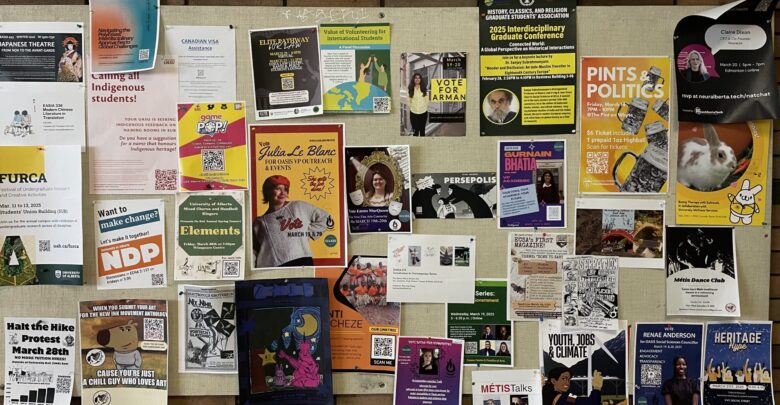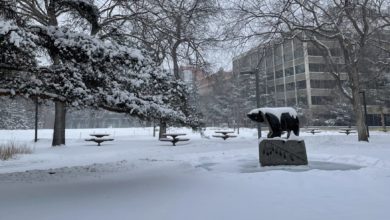What is student interest like when it comes to events on campus?
Two student groups and organizations, Ink Movement and EFSUN, detail the events their groups put on, and what student apathy towards events is like.
 Brooklyn Hollinger
Brooklyn HollingerHave you ever walked through the Humanities Centre (HC), the Tory Building, or even any other building at the University of Alberta and seen the dozens of posters that cover the bulletin boards? If you’ve ever bothered to look, you’ll notice posters for all kinds of events — from information sessions, to paint nights, to debate nights.
Everyday I walk past these poster-filled bulletin boards and wonder who goes to these events. After all, as a commuter student, I don’t often stay late on campus to attend events. I’m sure I’m not the only commuter student who feels that way. During a time when students are feeling isolated and wanting to make friends, I wanted to know what attendance was like for these events. Do people attend? Most importantly, what is student apathy towards these events like?
Seeking answers to my questions about campus-based events (CBEs), I spoke with the Co-president of Ink Movement, Kym Bahandi, as well as both the President and English and Creative Writing Co-ordinator of the English and Film Studies Undergraduate Network (EFSUN), Lidia Ballanyi, and Olivia Evjen.
Ink Movement sees engagement with their annual anthology and collaboration with other clubs
Ink Movement is a non-profit student group at the U of A that holds “free artistic events” for students. Their activities are also open to other creatives in Edmonton, especially youths in high school and even junior high school.
Bahandi explained that Ink Movement aims to have at least one in-person event every semester. They also have online events through their Discord server. In terms of attendance, Bahandi said “it really depends.”
“Some of our events are collaborations with other clubs. So usually [those events] have a bigger turnout because it’s a combination of both their audiences [and ours].”
She described an open mic event they held in collaboration with the Indigenous Students’ Union (ISU) and Students for Justice in Palestine (SJP) — which is a non-university affiliated organization. According to Bahandi, the turnout for this event was approximately 30 people. She also explained how Ink Movement held a Bob Ross paint night with around nine people in attendance.
Bahandi said that while Ink Movement puts on a range of events, from workshops to art markets to open mic nights, their annual anthology is the most popular. Last year, Ink Movement saw around 60 to 70 submissions. However, Bahandi emphasized that people will typically submit more than one piece of work.
When it comes to receiving feedback on their events, Bahandi explained the process of how their team reviews it.
“We usually [receive] positive feedback. For negative feedback we usually go through it as a team and think about what we did and what we could have done better after the event. But for the general audience they have positive feedback for events. Or they say ‘this was fun and I enjoyed it,'” Bahandi said.
Poetry nights prove to be the most popular and requested event for EFSUN
EFSUN is both a student group and departmental organization in the faculty of English and film studies (EFS).
“All of our events are open to everybody, but as a representative group we represent EFS students specifically,” Ballanyi said.
EFSUN has both an English and creative writing co-ordinator and a film studies co-ordinator. They each put on their own events specific to that category. Evjen explained how both she and the film studies co-ordinator try to do one to two events each per month.
“[The events] are aimed at anybody. As long as you show up and have a positive attitude, you are more than welcome to attend,” Evjen said.
For the English and creative writing events, anywhere from five to 15 students attend, according to Evjen. She explained how poetry and zine-making nights are “really well attended,” whereas game nights “are less attended.”
In terms of EFSUN’s most-attended event, Ballanyi said how their “beginning-of-year mixer” saw around 50 to 60 people.
“We had a lot of success with our beginning-of-year mixer because we reached out to a lot of different clubs on campus and invited them as well. And [we] asked them to share our promotion too,” Ballanyi said.
In terms of receiving feedback, it seems that students like the poetry nights the most. Evjen explained how after their first poetry night, she got numerous requests for a second one.
“I’ve had people suggest more poetry because the poetry events are so much fun. People love to share what they’ve been working on and I love listening to it,” Evjen said.
Both groups note the change in attendance since the COVID-19 pandemic and online classes
Having just passed five years since the World Health Organization (WHO) declared COVID-19 a pandemic, it’s clear that university clubs and student groups are still seeing its effect on CBE attendance.
Bahandi noted the decline in attendance “right after COVID-19.”
“I think [we’re] still seeing the lasting impacts of [the pandemic] as well. There’s been a lot more online events, and people prefer online events. Thinking about how COVID-19 impacted [events] is a pretty interesting aspect,” Bahandi said.
For Ballanyi, she noted not being able to go to events during her first two years due to classes being largely online.
“That’s why I like really pushing the [EFSUN] lounge as how we advertise ourselves, because it is such a valuable thing to have,” Ballanyi said.
What does this tell us about events on campus and student interest?
While it’s impossible to know where every students’ interests lie, for arts events put on by arts organizations, it seems that events and opportunities that promote creativity are among the most attended and interesting for students. However, that’s not to say that other events put on by clubs and student groups that don’t necessarily encourage creativity don’t also see interest. Both Ballanyi and Evjen explained how EFSUN’s film screenings see good attendance, and students often request certain films.
One thing remains clear. There are so many clubs and organizations at the U of A that put on events for students that aim to not only foster creativity, but community as well. While the amount of events may seem overwhelming, I’d encourage people to attend one every once in a while. You may find that you can share your interests with others, as well as your creative work. Or, at least you can say you didn’t just go straight home at the end of the day for your entire degree.




